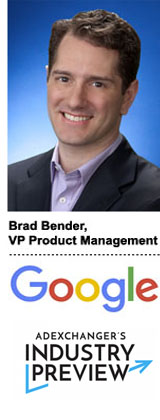
Brad Bender will speak at AdExchanger’s upcoming Industry Preview conference on Jan. 17-18, 2018, at the Grand Hyatt New York.
Google’s rallying cry for 2018? Better and possibly fewer ads.
While that theory may seem counterintuitive for a company whose revenues come almost exclusively from advertising, rethinking the ad experience may mean recutting standard formats or reducing ad loads altogether.
“A key area of focus for us is improving our targeting technologies using machine learning and ensuring we have better ad formats that work across web and mobile apps,” said Brad Bender, VP of product management for Google’s buy-side business (aka DoubleClick Bid Manager, DoubleClick Campaign Manager and the Google Display Network).
Despite Google’s YouTube brand safety issue, 2017 was the year Google dove headfirst into industrywide accountability initiatives such as the Coalition for Better Ads and new protocols like Ads.txt to prevent domain spoofing on publisher sites.
Bender predicts 2018 will be the year ad sustainability enters every discussion – from publishers and ad tech vendors to agencies and end buyers.
“When people are surfing online, they’re trying to get to the content they love and annoying ads are just irritating to users and, frankly, can be damaging to the entire industry,” Bender said. “If we don’t do something now, the problem will just get worse in our mobile-first, app-based economy.”
Bender spoke with AdExchanger.
AdExchanger: Google tried to cut down on “failing” ads last year. How are things progressing?
BRAD BENDER: If you look at the history of advertising, the first ads were literally signposts in the road. They included important information that helped people find directions and guided people to the places they wanted to go. We need to get back to those roots of ensuring advertising continues to be highly relevant and useful to people.
How is Google going to play a role?
I don’t think any one player, including Google, can solve for bad ad experiences alone. We need to have an industry approach that’s hopefully data-driven, focused on improving ad experiences.
It’s part of the reason why we joined the Coalition for Better Ads, announced Chrome’s plans to support better ad standards earlier this year and, starting Feb. 15, in line with those coalition guidelines, Chrome will remove ads from sites that have a failing status in the ad experience for more than 30 days.
Transparency itself, fundamentally, is something we’ve thought about on the ads side, but it goes beyond advertising. Users are demanding transparency from companies because they want control over their data and how that data is used. At Google, it’s why we rolled out tools like ad settings and My Activity, the intention being to give users transparency into the data collected and the ability to control that data as well.
How is that manifesting on the commercial side?
Billions of people trust their online identity to Google, so it’s critical that people who are using Google services have a clear and easy way of accessing that data and settings around those services.
2017 was a really important year for the industry. We had a lot of learning to do this year about the key issues the ad industry faced. There are still issues preventing us from growing as an industry, and they’re creating friction between our industry and the average user.
How is Google using machine learning to improve the quality and relevancy of ads?
Given the millions of data points we have to parse through to determine the right time, message and user to deliver any given advertising to, there’s a ton of leverage we get out of automation.
There are machine-learning capabilities that can really benefit our advertisers, whichever front end they decide to use, whether it’s DoubleClick Bid Manager or Google Display Network. We’re taking the power of Google machine learning … and automatically [determining] the best combination of bidding, targeting and creative to deliver results for advertisers.
What is Google’s stance on mar tech, considering you have a pretty robust product set beyond biddable media like Analytics 360 and the Google cloud infrastructure?
I oversee the DBM and GDN divisions, and it really is about having a single platform to plan, buy and measure across all of your digitally accessible campaigns. We want our digital marketing suite to be a place where you can manage that all holistically.
We want marketers to choose which workflow makes the most sense for them based on their size and level of sophistication.
You asked about how that overlaps with mar tech. We see these as things that all work together, either through product integrations across our own stack or through partnerships such as with Salesforce, which we announced this fall.
We’ve heard from customers that using that same infrastructure across our product suite, like DBM and DCM, is valuable because it lets them leverage these in a seamless way, and there’s natural synergies that result from having shared infrastructure here – like making sure we’re aligned on viewability detection and leaning into real proprietary strengths we have with machine learning.
Interview has been condensed and edited.
This post was syndicated from Ad Exchanger.

More Stories
McDonald’s Christmas Light Show is an Ode to Spontaneous Drive-Thru Dinners
Behind the Scenes of Coca-Cola’s AI Reinvention of a Holiday Classic
Here’s the Roundup for the Week Ending November 15